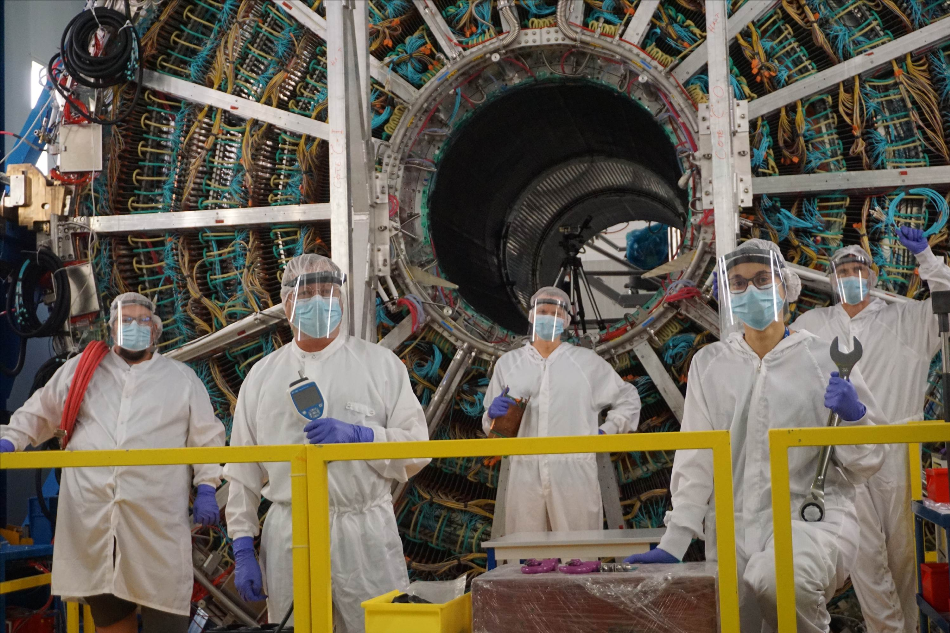Sep 18 2020
The accelerators at CERN are currently at rest in view of the “second long shutdown.” During this period, refurbishments and upgrades are made to the accelerators so that more particles can be expedited and the number of collisions can be increased in the days to come.
 Working on the ALICE detector under corona conditions: from the left: Robert Münzer (Goethe University Frankfurt, GU), Chilo Garabatos (GSI Helmholtz Centre for Heavy Ion Research), Lars Bratrud (GU), Yiota Chatzidaki (Heidelberg University), Christian Lippmann (GSI). Image Credit: Robert Münzer.
Working on the ALICE detector under corona conditions: from the left: Robert Münzer (Goethe University Frankfurt, GU), Chilo Garabatos (GSI Helmholtz Centre for Heavy Ion Research), Lars Bratrud (GU), Yiota Chatzidaki (Heidelberg University), Christian Lippmann (GSI). Image Credit: Robert Münzer.
Upgrades are also being made to the detectors. While CMS and ATLAS (the large all-purpose detectors) are not reserved for larger upgrades until the next, and third long shutdown in 2025, the ALICE specialized detector will enter the forthcoming measurement campaign that has already been upgraded.
ALICE is known to be an exclusive project among the research undertakings surrounding the Large Hadron Collider (LHC) of CERN.
Although the other three detectors are capable of interpreting what takes place during proton collision, the scientists in the ALICE experiment have concerns regarding lead ions—particles that are several times heavier.
Every year, lead ions are used to operate the LHC for one month so that data can be collected by the ALICE detector. The team wants to find out more about a specific state of matter called quark-gluon-plasma.
This plasma is produced within the ALICE experiment when lead nuclei crash into one another at intense energy and are disintegrated into their elementary components for a brief time.
In this hot and thick soup of matter, gluons and quarks, which are otherwise firmly fixed in the neutrons and protons, can move around almost freely. What occurs during the collisions may offer a better understanding of how the universe, known to humans today, developed from a massive primordial out of quark-gluon plasma.
Recording a Movie Instead of Taking Individual Pictures
Post the shutdown, the more improved ALICE detector will demonstrate what it is capable of doing today—earlier, the LHC accelerator was able to deliver 10,000 collisions every second.
At 18,000 particles for each collision, this amounts to a total of 180 million particles per second, only a part of which could be captured by the ALICE detector. Post the shutdown, the technological barriers, which have so far restricted the number of the recorded collisions, should have been removed.
Therefore, the LHC should subsequently deliver 50,000 collisions of lead ions for every second, leading to 900 million particles per second.
We want to record all collisions in entirety and, in fact, continuously, in other words, to record a movie instead of individual pictures.
Harald Appelshäuser, Professor, Institute for Nuclear Physics, Goethe University Frankfurt
Appelshäuser is also the project leader of the subdetector that is expected to make the biggest difference following the upgrade.
Detector Under Construction
To realize this, the Time Projection Chamber (TPC)—one of the core detectors of the 16-m high and 26-m long ALICE detector complex—was detected and meticulously brought from the underground detector cavern into a clean room on the surface.
Scientists then slowly and carefully installed different kinds of parts that were designed worldwide during the past few years. The technologically upgraded TPC has now been deployed to its home at the core of ALICE.
The highlights of this upgrade are the latest readout chambers which no longer contain the various fine wires, but basically consist of around five billion tiny holes. The signals of the charged particles in these tiny holes will be amplified so that the researchers can accurately compute the path of every particle.
These readout chambers are known as “GEMs" (Gas Electron Multipliers), and were invented by CERN and are already being used in medical procedures. A total of 500,000 channels make sure that nothing eludes the ALICE experiment. Every second at the time of collisions subsequently results in 3.4 terabytes of data. Novel processes should also be designed to process this large amount of data.
With the involvement of high-performance computing expert Professor Volker Lindenstruth and his collaborators, Goethe University scientists will also be playing a crucial role here.
We now have the finest of the fine and look forward to the first collisions.
Harald Appelshäuser, Professor, Institute for Nuclear Physics, Goethe University Frankfurt
The latest GEM readout chambers were customized for the ALICE experiment, thanks to testing and development in Germany—at Goethe University Frankfurt and also at the Bonn and Heidelberg Universities, the Technical University Munich, and the GSI Helmholtzzentrum für Schwerionenforschung, and subsequently assembled in different nations, which apart from Germany, included Finland, Hungary, the USA, and Romania.
The logistics were pretty complicated. The TPC was brought to the clean room in 2019 that was where we removed the older chambers and installed and tested the new ones. Luckily, we had just finished before the pandemic started.
Harald Appelshäuser, Professor, Institute for Nuclear Physics, Goethe University Frankfurt
During the long shutdown, the ALICE detector will also receive a novel inner tracking chamber, placed closer to the collision point and considerably increasing the accuracy when compared to its predecessor.
The detectors also need to be accurate because precise determination of particle energies and particle paths will help reach conclusions about the first split seconds of the universe.
Source: https://www.goethe-university-frankfurt.de/en